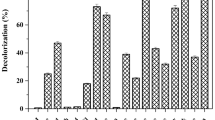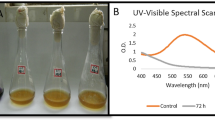Abstract
This study represents the development of a new batch method by consortium GG-BL using two microbial cultures viz., Galactomyces geotrichum MTCC 1360 and Brevibacillus laterosporus MTCC 2298, by varying environmental conditions for the decolorization and biodegradation of Rubine GFL. Consortium was found to give better decolorization and degradation of Rubine GFL as compared to the individual microorganism at aerobic/microaerophilic process. The consortial metabolic activity of these strains lead to 100% decolorization of Rubine GFL (50 mg/L) within 30 h with significant reduction in chemical oxygen demand (79%) and total organic carbon (68%). Induction in the activities of laccase, veratryl alcohol oxidase, tyrosinase, azo reductase, and riboflavin reductase suggested their role in the decolorization process. Nondenaturing polyacrylamide gel electrophoresis analysis showed differential induction pattern of oxidoreductive enzymes during decolorization of the dye at different incubation temperatures. The degradation of Rubine GFL into different metabolites by individual organism and in consortium was confirmed using high performance thin layer chromatography, high performance liquid chromatography, Fourier transform infrared spectroscopy, and gas chromatography-mass spectroscopy analysis. Phytotoxicity studies revealed nontoxic nature of the metabolites of Rubine GFL.






Similar content being viewed by others
References
Tony, B. D., Goyal, D., & Khanna, S. (2009). International Biodeterioration & Biodegradation, 63, 462–469.
Sponza, D. T., & Isik, M. (2005). Process Biochemistry, 40, 2735–2744.
Supaka, N., Juntongjin, K., Damronglerd, S., Delia, M., & Strehaiano, P. (2004). Chemical Engineering Journal, 99, 169–176.
Banat, I. M., Nigam, P., Singh, D., & Merchant, R. (1996). Bioresource Technology, 58, 217–227.
Tamboli, D. P., Kagalkar, A. N., Jadhav, M. U., Jadhav, J. P., & Govindwar, S. P. (2010). Bioresource Technology, 101, 2421–2427.
Amoozegar, M. A., Hajighasemi, M., Hamedi, J., Asad, S., & Ventosa, A. (2011). Annals of Microbiology, 61, 217–230.
Saratale, R. G., Saratale, G. D., Chang, J. S., & Govindwar, S. P. (2011). Journal of the Taiwan Institute of Chemical Engineers, 42, 138–157.
Farabegoli, G., Chiavola, A., Rolle, E., & Naso, M. (2010). Biochemical Engineering Journal, 52, 220–226.
Senan, R. C., & Abraham, T. E. (2004). Biodegradation, 15, 275–280.
Sponza, D. T., & Isik, M. (2002). Enzyme and Microbial Technology, 31, 102–110.
Frijters, C. T. M. J., Vos, R. H., Scheffer, G., & Mulder, R. (2006). Water Research, 40, 1249–1257.
Moosvi, S., & Madamwar, D. (2007). Bioresource Technology, 98, 3384–3392.
Albuquerque, M. G. E., Lopes, A. T., Serralheiro, M. L., Novais, J. M., & Pinheiro, H. M. (2005). Enzyme and Microbial Technology, 36, 790–799.
Isik, M., & Sponza, D. T. (2008). Separation and Purification Technology, 60, 64–72.
You, S., Damodar, R. A., & Hou, S. (2010). Journal of Hazardous Materials, 177, 1112–1118.
Li, Z., Zhang, X., Lin, J., Han, S., & Lei, L. (2010). Bioresource Technology, 101, 4440–4445.
Phugare, S. S., Kalyani, D. C., Patil, A. V., & Jadhav, J. P. (2011). Journal of Hazardous Materials, 186, 713–723.
APHA-AWWA-WEF. (2005). Washington, DC: American Public Health Association.
Waghmode, T. R., Kurade, M. B., & Govindwar, S. P. (2011). International Biodeterioration & Biodegradation, 65, 479–486.
Tamboli, D. P., Kurade, M. B., Waghmode, T. R., Joshi, S. M., & Govindwar, S. P. (2010). Journal of Hazardous Materials, 182, 169–176.
Kandaswami, C., & Vaidyanathan, C. S. (1973). Journal of Biological Chemistry, 248, 4035–4039.
Telke, A. A., Joshi, S. M., Jadhav, S. U., Tamboli, D. P., & Govindwar, S. P. (2010). Biodegradation, 21, 283–296.
Saratale, R. G., Saratale, G. D., Chang, J. S., & Govindwar, S. P. (2009). Journal of Hazardous Materials, 166, 1421–1428.
Chen, K. C., Wu, J. Y., Liou, D. J., & Hwang, S. C. J. (2003). Journal of Biotechnology, 101, 57–68.
Jadhav, U. U., Dawkar, V. V., Tamboli, D. P., & Govindwar, S. P. (2009). Bioprocess Engineering, 14, 369–376.
Phugare, S. S., Waghmare, S. R., & Jadhav, J. P. (2011). World Journal of Microbiology and Biotechnology, 27, 2415–2423.
Parshetti, G. K., Telke, A. A., Kalyani, D. C., & Govindwar, S. P. (2010). Journal of Hazardous Materials, 176, 503–509.
Jadhav, S. U., Jadhav, U. U., Dawkar, V. V., & Govindwar, S. P. (2008). Biotechnology and Bioprocess Engineering, 13, 1–8.
Patil, P. S., Phugare, S. S., Jadhav, S. B., & Jadhav, J. P. (2010). Journal of Hazardous Materials, 181, 263–270.
Kabra, A. N., Khandare, R. V., Waghmode, T. R., & Govindwar, S. P. (2011). Journal of Hazardous Materials, 190, 424–431.
Acknowledgements
Mr. T. R. Waghmode and M. B. Kurade wish to thank the Department of Biotechnology, New Delhi, India, for providing Junior Research Fellowship. Dr. Harshad Lade wishes to thank the University Grant commission, New Delhi, India, for providing Dr. D. S. Kothari postdoctoral fellowship. Prof. S. P. Govindwar wishes to thank the Department of Biotechnology, New Delhi, for financial support to this project.
Author information
Authors and Affiliations
Corresponding author
Rights and permissions
About this article
Cite this article
Waghmode, T.R., Kurade, M.B., Lade, H.S. et al. Decolorization and Biodegradation of Rubine GFL by Microbial Consortium GG-BL in Sequential Aerobic/Microaerophilic Process. Appl Biochem Biotechnol 167, 1578–1594 (2012). https://doi.org/10.1007/s12010-012-9585-z
Received:
Accepted:
Published:
Issue Date:
DOI: https://doi.org/10.1007/s12010-012-9585-z




